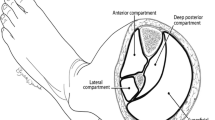Abstract
Conventional vascular surgery and balloon angioplasty have poor results in severe and diffuse atherosclerotic disease of the infrapopliteal arteries. High-speed rotational atherectomy (Auth Rotablator) has not succeeded either, because of poor long-term patency and the non-reflow phenomenon. We report a case of limb salvage with long occlusion of the three infrapopliteal vessels. The anterior tibial artery was treated with retrograde Auth Rotablator atherectomy by an open approach through the pedal artery, resulting in full patency of the anterior tibial artery and healing of the skin lesions. The microparticulate debris from the ablation was drained out through the pedal arteriotomy, avoiding the complications associated with conventional antegrade high-speed rotational atherectomy.





Similar content being viewed by others
References
Botti CF Jr, Ansel GM, Silver MJ, Barker BJ, South S (2003) Percutaneous retrograde tibial access in limb salvage. J Endovasc Ther 10:614–618
Peripheral atherectomy with the Rotablator: A multicenter report (1994) The Collaborative Rotablator Atherectomy Group (CRAG). J Vasc Surg 19:509–515
Rutherford RB, Durham JD, Kumpe DA (1995) Endovascular interventions for lower extremity ischemia. In: Rutherford RB (ed) Vascular surgery, 4th edn, vol 1. Philadelphia: WB Saunders, pp 858–874
Kumpe DA, Becker GJ (1995) Percutaneous transluminal angioplasty and other endovascular technologies. In: Rutherford RB (ed) Vascular surgery, 4th edn, vol 1. Philadelphia: WB Saunders, pp 352–394
Ahn SS, Concepcion B (1996) Current status of atherectomy for peripheral arterial occlusive disease. World J Surg 20:635–643
Smith FB, Lee AJ, Price JF, van Wijk MC, Fowkes FG (2003) Changes in ankle brachial index in symptomatic and asymptomatic subjects in the general population. J Vasc Surg 38:1323–1330
Dorros G, Iyer S, Zaitoun R, Lewin R, Cooley R, Olson K (1991) Acute angiographic and clinical outcome of high speed percutaneous rotational atherectomy (Rotablator). Cathet Cardiovasc Diagn 22:157–166
Zacca NM, Raizner AE, Noon GP, et al. (1989) Treatment of symptomatic peripheral atherosclerotic disease with a rotational atherectomy device. Am J Cardiol 63:77–80
Author information
Authors and Affiliations
Corresponding author
Rights and permissions
About this article
Cite this article
Tamashiro, A., Villegas, M., Tamashiro, G. et al. Retrograde Rotablator in Limb Salvage: A New Technique Using an Open Approach. Cardiovasc Intervent Radiol 29, 854–856 (2006). https://doi.org/10.1007/s00270-005-0306-7
Published:
Issue Date:
DOI: https://doi.org/10.1007/s00270-005-0306-7




